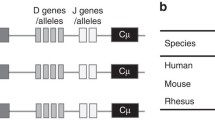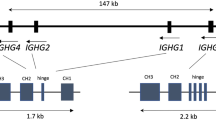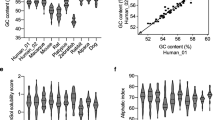Abstract
We describe a bioinformatic analysis of germline and rearranged immunoglobulin kappa chain (IGK) gene sequences, performed in order to assess the completeness and reliability of the reported IGK repertoire. In contrast to the reported heavy-chain gene repertoire, which includes many dubious sequences, only five IGK variable gene (IGKV) alleles appear to have been reported in error. There was, however, insufficient evidence to justify removing these IGKV genes from the germline repertoire. Bioinformatic analysis of apparent mismatches between reported germline genes and 1,863 expressed IGK sequences suggested the existence of two unreported IGKV polymorphisms. Genomic screening of 12 individuals led to the confirmation of both of these polymorphisms, IGKV1-16*02 and IGKV2-30*02. We also show that in contrast to the heavy chain, the IGK repertoire is dominated by sequences that use just a handful of kappa variable (IGKV) and junction (IGKJ) gene pairs. There is also little modification of IGKV and IGKJ genes by the processes of exonuclease removal and N nucleotide addition. The expressed IGK repertoire therefore lacks diversity and the junction region is particularly constrained. Remarkably, the analysis of a dataset of 435 relatively unmutated rearranged kappa genes showed that ten amino acid sequences account for almost 10% of the rearrangements, with identical sequences being derived from as many as seven independent sources. Such dominant sequences are likely to have important roles in the operation of the humoral immune response.

Similar content being viewed by others
References
Atkinson MJ, Cowan MJ, Feeney AJ (1996) New alleles of IGKV genes A2 and A18 suggest significant human IGKV locus polymorphism. Immunogenetics 44:115–120
Barbie V, Lefranc MP (1998) The human immunoglobulin kappa variable (IGKV) genes and joining (IGKJ) segments. Exp Clin Immunogenet 15:171–183
Cox JPL, Tomlinson IM, Winter G (1994) A directory of human germ-line Vk segments reveals a strong bias in their usage. Eur J Immunol 24:827–836
Dahlke I, Nott DJ, Ruhno J, Sewell WA, Collins AM (2006) Antigen selection in the IgE response of allergic and non-allergic individuals. J Allergy Clin Immunol 117:1477–1483
Farner NL, Dorner T, Lipsky PE (1999) Molecular mechanisms and selection influence the generation of the human V lambda J lambda repertoire. J Immunol 162:2137–2145
Feeney AJ, Atkinson MJ, Cowan MJ, Escuro G, Lugo G (1996) A defective Vkappa A2 allele in Navajos which may play a role in increased susceptibility to haemophilus influenzae type b disease. J Clin Invest 97:2277–2282
Giudicelli V, Chaume D, Lefranc MP (2004) IMGT/V-QUEST, an integrated software program for immunoglobulin and T cell receptor V-J and V-D-J rearrangement analysis. Nucleic Acids Res 32:W435–W440
Gotoh O (1982) An improved algorithm for matching biological sequences. J Mol Biol 162:705–708
Jackson KJ, Gaeta B, Collins AM (2007) Identifying highly mutated IGHD genes in the junctions of rearranged human immunoglobulin heavy chain genes. J Immunol Methods 324:26–37
Kanz C, Aldebert P, Althorpe N, Baker W, Baldwin A, Bates K, Browne P, van den Broek A, Castro M, Cochrane G, Duggan K, Eberhardt R, Faruque N, Gamble J, Diez FG, Harte N, Kulikova T, Lin Q, Lombard V, Lopez R, Mancuso R, McHale M, Nardone F, Silventoinen V, Sobhany S, Stoehr P, Tuli MA, Tzouvara K, Vaughan R, Wu D, Zhu W, Apweiler R (2005) The EMBL nucleotide sequence database. Nucleic Acids Res 33:1
Lee CEH, Gaëta B, Malming HR, Bain ME, Sewell WA, Collins AM (2006) Reconsidering the human immunoglobulin heavy chain locus. 1. An evaluation of the expressed human IGHD gene repertoire. Immunogenetics 57:917–925
Lee CEH, Jackson KJL, Sewell WA, Collins AM (2007) Use of IGHJ and IGHD gene mutations in analysis of immunoglobulin sequences for the prognosis of chronic lymphocytic leukemia. Leuk Res 31:1247–1252
Meijer P-J, Andersen PS, Haahr Hansen M, Steinaa L, Jensen A, Lantto J, Oleksiewicz MB, Tengbjerg K, Poulsen TR, Coljee VW, Bregenholt S, Haurum JS, Nielsen LS (2006) Isolation of human antibody repertoires with preservation of the natural heavy and light chain pairing. J Mol Biol 358:764–772
Mehr R, Shannon M, Litwin S (1999) Models for antigen receptor gene rearrangement. I. Biased receptor editing in B cells: implications for allelic exclusion. J Immunol 163:1793–1798
Olee T, Yang PM, Siminovitch KA, Olsen NJ, Hillson J, Wu J, Kozin F, Carson DA, Chen PP (1991) Molecular basis of an autoantibody-associated restriction fragment length polymorphism that confers susceptibility to autoimmune diseases. J Clin Invest 88:193–203
Pallares N, Lefebvre S, Contet V, Matsuda F, Lefranc MP (1999) The human immunoglobulin heavy variable genes. Exp Clin Immunogen 16:36–60
Smith TF, Waterman MS (1981) Identification of common molecular subsequences. J Mol Biol 147:195–197
Stamatopoulos K, Belessi C, Moreno C, Boudjograh M, Guida G, Smilevska T, Belhoul L, Stella S, Stavroyianni N, Crespo M, Hadzidimitriou A, Sutton L, Bosch F, Laoutaris N, Anagnostopoulos A, Montserrat E, Fassas A, Dighiero G, Caligaris-Cappio F, Merle-Beral H, Ghia P, Davi F (2007) Over 20% of patients with chronic lymphocytic leukemia carry stereotyped receptors: pathogenetic implications and clinical correlations. Blood 109:259–270
Thompson JD, Higgins DG, Gibson TJ (1994) CLUSTAL W: improving the sensitivity of progressive multiple sequence alignment through sequence weighting, position-specific gap penalties and weight matrix choice. Nucleic Acids Res 22:4673–4680
Tomlinson IM, Cox JP, Gherardi E, Lesk AM, Chothia C (1995) The structural repertoire of the human V kappa domain. EMBO J 14:4628–4638
Wang Y, Jackson KJL, Sewell WA, Collins AM (2008) Many human immunoglobulin heavy-chain IGHV gene polymorphisms have been reported in error. Immunol Cell Biol 86:111–115
Zachau HG (1993) The immunoglobulin kappa locus-or-what has been learned from looking closely at one-tenth of a percent of the human genome. Gene 135:167–173
Acknowledgements
This study was supported by a grant from the National Health and Medical Research Council.
Author information
Authors and Affiliations
Corresponding author
Rights and permissions
About this article
Cite this article
Collins, A.M., Wang, Y., Singh, V. et al. The reported germline repertoire of human immunoglobulin kappa chain genes is relatively complete and accurate. Immunogenetics 60, 669–676 (2008). https://doi.org/10.1007/s00251-008-0325-z
Received:
Accepted:
Published:
Issue Date:
DOI: https://doi.org/10.1007/s00251-008-0325-z




